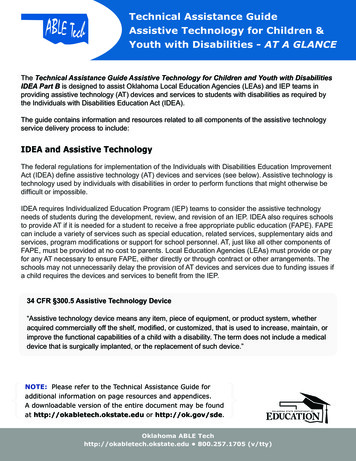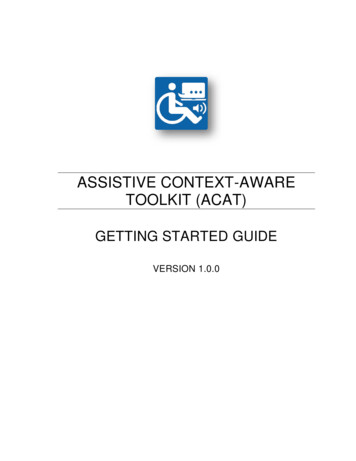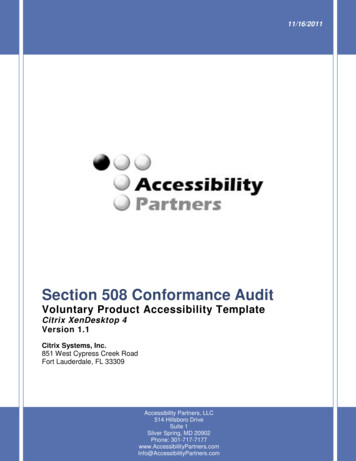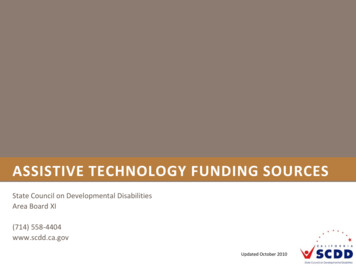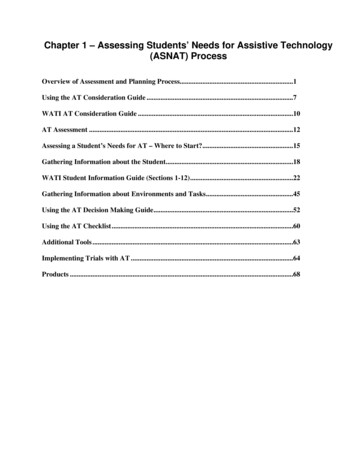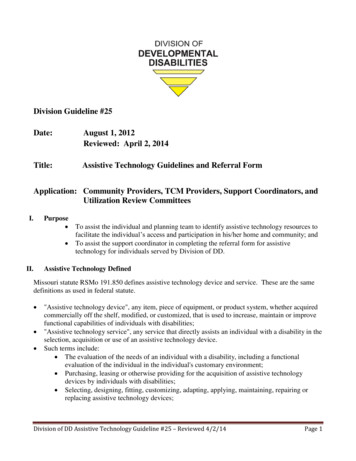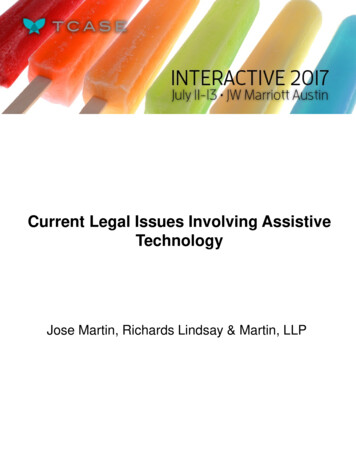
Transcription
Current Legal Issues Involving AssistiveTechnologyJose Martin, Richards Lindsay & Martin, LLP
Current Legal IssuesInvolving Assistive TechnologybyJose L. Martín, Attorney at LawRICHARDS LINDSAY & MARTÍN, L.L.P.13091 Pond Springs Rd., Suite 300Austin, Texas 78729Tel. (512) 918-0051jose@rlmedlaw.comCopyright 2017 Richards Lindsay & Martín, L.L.P.Learning Objectives1.Understand the key operative IDEA regulations addressing assistivetechnology (AT) and AT services2.Identify individual students’ situations and factors that would require ATevaluation.3.Learn how to avoid problems in implementation and maintenance of AT.4.Explore cases to identify practical steps to prevent disputes involving choiceof AT.5.Understand AT service and training requirements associated with providingAT.6.Learn how to properly incorporate AT into students’ IEPs.7.Review challenges posed in providing computer/tablet AT to students withdisabilities.8.Know the rules governing medically prescribed and surgically implanteddevices.Operative RegulationsIn amendments made to the Education of the Handicapped Act (now1
IDEA) in 1990, the Congress first added definitions for “assistive technologydevice” and assistive technology service.” See Pub. L. 101476 (1990 Amendments)at then 20 U.S.C. §1401(a)(25) and (a)(26); cited in Letter to Anonymous, 21 IDELR1057 (OSEP 1994). The following are the present-day IDEA regulations addressingAT:34 C.F.R. §300.5Assistive technology device.Assistive technology device means any item, piece of equipment, or productsystem, whether acquired commercially off the shelf, modified, or customized,that is used to increase, maintain, or improve the functional capabilities of a childwith a disability. The term does not include a medical device that is surgicallyimplanted, or the replacement of such device.34 C.F.R. §300.6Assistive technology service.Assistive technology service means any service that directly assists a child with adisability in the selection, acquisition, or use of an assistive technology device.The term includes—(a)The evaluation of the needs of a child with a disability, including afunctional evaluation of the child in the child's customary environment;(b)Purchasing, leasing, or otherwise providing for the acquisition of assistivetechnology devices by children with disabilities;(c)Selecting, designing, fitting, customizing, adapting, applying, maintaining,repairing, or replacing assistive technology devices;(d)Coordinating and using other therapies, interventions, or services withassistive technology devices, such as those associated with existingeducation and rehabilitation plans and programs;(e)Training or technical assistance for a child with a disability or, ifappropriate, that child's family; and(f)Training or technical assistance for professionals (including individualsproviding education or rehabilitation services), employers, or otherindividuals who provide services to, employ, or are otherwise Must .34 C.F.R. §300.105Assistive technology.2
(a) Each public agency must ensure that assistive technology devices or assistivetechnology services, or both, as those terms are defined in §§ 300.5 and 300.6,respectively, are made available to a child with a disability if required as a part ofthe child's—(1)Special education under § 300.36;(2)Related services under § 300.34; or(3)Supplementary aids and services under §§ 300.38 and 300.114(a)(2)(ii).(b)On a case-by-case basis, the use of school-purchased assistive technologydevices in a child's home or in other settings is required if the child's IEPTeam determines that the child needs access to those devices in order toreceive FAPE.Comment—Note the exclusion for surgically implanted devices, which wasincluded in IDEA 2004. Also, note that the regulations treat AT and ATservices as either special education, related services, or supplementary aidsand services. The regulations also envision that the IEP team, on a case-bycase basis may determine that school-purchased AT is needed in the homeor other settings in order for a child to receive FAPE.34 C.F.R. §300.324(a)(2)(v)The IEP Team must—consider whether the child needs assistivetechnology devices and services.AT Evaluations and Consideration of ATThe IDEA regulations state that AT services include “the evaluation of theneeds of a child with a disability, including a functional evaluation of the child inthe child's customary environment.” 34 C.F.R. §300.6(a). In addition, anotherregulation requires IEP teams to consider whether a student needs AT devicesand services. 34 C.F.R. §300.324(a)(2)(v). But, there is no firm requirement for ATevaluations for all students with disabilities. In addition, the IDEA does not specifywho should conduct AT evaluations or how they should be conducted, beyondrequiring that they include “a functional evaluation of the child in the child'scustomary environment.” 34 C.F.R. §300.6(a). Generally, however, schools maywant to train staff that conduct AT evaluations on current technology applicationsfor the education of students with disabilities. At times, schools may contract withAT consultants or create teams of staffpersons that include staff knowledgeable3
in the area of disability to conduct AT evaluationsThe cases below illustrate disputes over whether schools should haveundertaken actual AT evaluations in their consideration of the student’s need forAT. Sometimes, hearing officers and courts may excuse the lack of an ATevaluation if it is clear that the school has provided appropriate AT that hasassisted the student in receiving a FAPE. Other cases contain specific facts thatled the hearing officers or courts to find that the lack of AT evaluation violatedthe IDEA under the circumstances.Letter to Fisher, 23 IDELR 565 (OSEP 1995)LEAs must ensure that its evaluations, when warranted, assess “thestudent’s functional capabilities and whether they may be increased, maintained,or improved through the use of assistive devices or services. The evaluationshould provide sufficient information to permit the IEP team to determinewhether the student requires assistive technology devices or services in order toreceive FAPE.” OSEP also stated that if parents disagree with a district’s evaluationbecause it fails to address need for AT, they may request an IEE or request thatthe school assess the area of AT.Comment—First, OSEP reemphasizes that IEP teams must determinewhether an AT evaluation is warranted. In addition, according to OSEP,parents can request IEEs if they disagree with the school’s AT evaluation,or if they disagree with a school evaluation because it fails to assess thearea of AT need.R.P. v. Alamo Heights Independent Sch. Dist., 60 IDELR 60 (5th Cir. 2012)Although a District delayed for nearly a year in reviewing an AT evaluationfor a nonverbal 10-year-old with Autism, ID, and speech impairments, it did notdeny her a FAPE. Initially, the school used the picture exchange communicationsystem (PECS), although it also tried a voice output device (Go Talk) that theparents were using at home. When the student’s expressive language wasreported to have declined at home, the IEP team ordered an AT assessment tofocus on communication devices. The IEP team did not review that AT evaluationuntil nearly a year later. By that time, the student was already using another voiceoutput device (DynaVox) with agreed success. The parents requested a hearingon, among other issues, the AT problem. The Court found that the District failedto timely review its AT evaluation. But, it rejected the parents’ contention that as a4
result, the student was denied appropriate AT, since she was progressing usingthe PECS system even though the AT evaluation had not been reviewed, and theCourt viewed PECS as AT. “While AHISD’s handling of the Fall 2008 ATassessment was not optimum,” the Court found that the student received a FAPE.Comment—Another court could have found that the IEP team’s failure totimely review the AT evaluation was a procedural violation that seriouslyinfringed on the parents’ opportunity for meaningful participation in theIEP process, and thus denied the student a FAPE. The District here skirtedwith real legal danger in neglecting to review its own completed ATevaluation.E.F. v. Newport Mesa Unified Sch. Dist., 65 IDELR 265 (C.D.Cal. 2015)A California school knew that a six-year-old with Autism was successfullyusing an iPad for entertainment purposes. In the meantime, the District had beenusing the picture exchange communication system (PECS) with little success, asthe student primarily communicated by pointing, eye gazes, and leading personsby the hand. Nevertheless, the school waited nearly a year before conducting anAT evaluation and providing an iTouch device for functional communication. Itdid so only after a private evaluator pointed out that the student was able andwilling to use iTouch to communicate, did the District decide to conduct an ATevaluation. The ALJ found that “given Student’s interest in using the iPad and hissuccess with it, the District should have at least assessed Student right afterdiscovering his ability to use the iPad.” The reviewing Court agreed with thehearing officer and the award of compensatory services, although it disagreedwith the parents’ contention that the student should have been evaluated for ATeven earlier, finding that “prior to learning about E.F.'s success with an iPad inFebruary 2012, however, the District was reasonable to believe that E.F. was notyet ready to start using ‘high-tech’ devices, as his knowledge regarding suchcommunication was still emerging.”Comment—If staff discover that a child is already making use of an ATdevice successfully, the IEP team may want to consider an AT evaluation toassess whether the device could be used for education applications, orwhether a similar device might be more adaptable to the classroomenvironment and tasks.A.L. v. Chicago Pub. Sch. Dist. No. 299, 111 LRP 71856 (N.D.Ill. 2011)5
The parent of a high-schooler with a mild cognitive impairment challengeda District AT evaluation that concluded that the student did not need significantAT. The Court noted that the AT evaluation identified the student’s needs andproperly assessed whether AT “would be useful in minimizing AL’s writing deficits,and whether auditory or visual input helped to increase AL’s comprehension.” Theresults indicated that the student received no clear benefit from AT, butnonetheless recommended the use of writing and symbol software. The Courtheld that the parent failed to prove a violation of IDEA arising from the ATevaluation.Glendora Unified Sch. Dist., 49 IDELR 172 (SEA California 2007)A school employee unilaterally decided to deny two parental requests forAT evaluation for a deaf high school student. The parent requested theevaluations to address the student’s potential need for Communication AccessReal-Time Translation (CART). After each request, a District staffperson told theparent that the student did not require CART, and thus, the AT evaluation was notneeded. The ALJ found that although there is “no express requirement that aschool district perform an assistive technology evaluation,” AT and AT servicesmay be required as part of the child’s program. The denial of AT evaluations,when there was an apparent need to address the student’s communication needsand other deficits was inappropriate, particularly when the denial was madeunilaterally by a staffperson. The District was providing an FM system that wasnot fully compatible with the student’s cochlear implant. Moreover, while the FMsystem allowed him to hear the teacher, he could not hear peer comments, whichmeant he could not participate in classroom discussions, which were acomponent of several of his classes. Some teachers testified that the studentwould benefit from CART, and none felt that the student of CART would bedisruptive or detrimental to the student or the class. In addition, the student’stest scores and grades “have shown a pattern of decline.” The ALJ thus held thatthe student was not provided with meaningful access to the curriculum, as he hadto miss out on classroom discussion and a substantial portion of the curriculum.The District was ordered compensatory services and implementation of CART.Comment—Outright denial of an AT evaluation when specificallyrequested by the parent is questionable, but having a staffpersonunilaterally rejecting the AT evaluation outside of the IEP team process is aclear mistake. Since there was an active question as to whether the presentFM system was meeting the student’s communication needs versus CARTservices, common sense would dictate that such question would need to6
be resolved through an AT evaluation. The AT evaluation might haveidentified alternatives to CART that could have met the student’s need tohear classroom discussion, as well as the teacher’s voice. Or, it might haveconclusively shown that CART was the only viable option to address theneeds.Montgomery County Pub. Schs., 114 LRP 47714 (SEA Maryland 2014)An AT evaluation of a 2nd-grader with visual impairments had the studenttry different tablet computers, one of which seemed helpful for reading. But, theevaluation ultimately recommended a magnification device for viewing awhiteboard, magnification software for viewing a computer, and otheraccommodations, but not the tablet. When the parents requested an IEE, theDistrict refused and requested a hearing to prove the appropriateness of its ATevaluation. The ALJ found that the District’s evaluator was qualified to conductthe assessment, used several assessment tools, and administered a properassessment. He also noted that while a tablet could be an appropriate AT for achild with a visual impairment, it is not the only AT that can enable the student toaccess the curriculum. Importantly, the ALJ held that, to be appropriate, an ATevaluation does not have to determine which AT might be the best option.Ultimately, the parent’s argument was that the iPad was a “preferable” device,and that the AT evaluation did not specifically consider an iPad. The ALJ thusdenied the parent’s request for an IEE at public expense.Comment—This case also touches on the issue of choice of AT. While aniPad may have more multifaceted uses and applications, if the ATevaluation recommends AT that specifically address the student’sparticular AT needs, both the evaluation and the AT it recommends arelikely to be upheld legally, even if the recommended AT has less universalpotential application.Antelope Valley Union High Sch. Dist., 110 LRP 33085 (SEA California 2010)Without conducting an AT evaluation, a California District provided astudent with dyslexia a portable Fusion text-to-speech system (3’’x 7” size) withheadphones, after the student complained that the Fusion speaker made him“stand out” too much in class. The teacher trained himself and the student on thedevice and offered to train the parent, who declined. The student thencomplained that the device was too heavy to carry in his backpack. The studentstarted refusing to use the device, instead asking for a notebook computer to7
assist in writing (he had previously refused to use an AlphaSmart word processingdevice also). The District noted that a notebook computer would be even heavierthan the Fusion device, and would add other distractions, such as the internetand social media programs, which the student would want to access. The ALJ,however, found that the District improperly attributed the student’s failure toaccess his ATs to behavioral resistance, instead of conducting an AT evaluation toaddress the problem. “Knowing that Student was not benefitting from his ATrelated services put the District on notice to make concerted efforts and inquiriesto develop AT-related services which benefitted student.” Although the Districtchanged the AT from the AlphaSmart to the Fusion, “the change or upgrade inthe AT device was not based on a comprehensive assessment of student’s ATcapabilities and needs,” which apparently included fine-motor deficits and avisual processing disorder. The lack of AT evaluation, moreover, impeded theparents’ opportunity to meaningfully participate in the IEP process. “District’s ATapproach was to decide what Student needed, give it to him, monitor the AT use,and blame him if AT did not help.”Comment—While a student’s preferences are a factor in making the ATdetermination, a student’s refusal to use a device does not mean the AT isnot appropriate to meet his needs. Ultimately, however, the District’sfailure to conduct an AT evaluation when the provision of AT had clearlyproved problematic for a student with fairly complex needs was the mainproblem in its position. An AT evaluation would have weighed the relativebenefits and drawbacks of the student’s preferred options against anydrawbacks and the benefits of District-provided devices. An AT evaluationcould have also assessed the degree to which the student’s resistance waspurely behavioral, rather than based on the merits of the various AToptions, and determined the impact of fine-motor and vision processingdeficits.District of Columbia Pub. Schs., 67 IDELR 134 (SEA DC 2015)The parents of a high-school student with SLD challenged the District’sfailure to conduct a timely AT evaluation after they raised the possibility of thestudent using an iPad for organizational purposes. While the District did notcommit to providing an iPad, it let the student use his own iPad at school to laterassess his AT needs after he had used the device for a time. The ALJ first notedthat “a parent may not select the assessments for a school district. The types ofassessments to be employed in a reevaluation are within the reasonablediscretion of the school district.” Since the ALJ felt that the IEP team adequately8
addressed the student’s needs in the area of organization by other means, he didnot find that a failure to conduct an AT evaluation earlier was a violation of IDEA.Moreover, he noted that the District in fact agreed to conduct an AT assessmentafter the student had used his iPad for some time.Comment—In dicta, the ALJ stated that “an assistive technologyassessment is not an evaluation.” This conclusion seems contrary to OSEP’sposition in Letter to Fisher, 23 IDELR 565 (OSEP 1995), which holds thatparents that disagree with AT evaluations may request an IEE, thusimplying that AT evaluations are “evaluations,” or parts thereof, within themeaning of IDEABastrop Independent Sch. Dist., 116 LRP 13753 (SEA Texas 2016)A child with SLD, anxiety, attention deficits, and cognitive, memory, andexecutive function difficulties challenged his IEP on various grounds, includingAT. In prior years, the District had conducted an AT evaluation, although it didnot include a trial plan for AT devices. District staff testified that the student hadaccess to AT per his IEP, but chose not to use it, but felt that it did not impede hisprogress. Instead, the student was using another AT device of his own. Thehearing officer held that given that the student’s needs had changed, and thestudent was not using the AT provided by the District, but one of his own, the IEPteam should have decided to conduct an updated AT evaluation. “It would beappropriate to conduct a new evaluation to discover how best to use assistivetechnology to accommodate the student’s memory issues.”Comment—The hearing officer’s statement that the AT evaluation mustidentify how to “best” use AT seems to impose a higher legal standardthan Rowley requires. Likely, however, the remark is not intended as astatement of the applicable legal standard, but rather to highlight that thestudent’s circumstances and needs (not using the District AT, and insteadusing his own AT) dictated the need for a new AT evaluation to identifyappropriate AT that would assist the student in benefitting from hisinstructional program.Orangeville Comm. Unit Sch. Dist. 203, 112 LRP 1209 (SEA Illinois 2012)A 14-year-old with arthritis exhibited difficulty climbing stairs, and, attimes, holding a pen for writing. Of her own initiative, a teacher obtained a laptopfor the student to use when she had difficulty holding a pen. The ALJ held that9
the student’s difficulty with writing instruments should have alerted the Districtthat an AT evaluation was necessary. This failure, together with other IEPdeficiencies, led to a denial of FAPE.Comment—The ALJ did not explain whether the teacher-provided laptopproperly addressed the specific issue, arthritis flare-ups that periodicallymade it difficult for the student to hold a pen for writing. Other ALJs andcourts might have examined that question before determining that thelack of AT evaluation was a violation of IDEA.North Hills Sch. Dist. v. M.B., 65 IDELR 150 (Pa. Comm. Ct. 2015)A District was aware of the severe communication deficits of an 8-year-oldwith Autism since his Kindergarten year. In first grade, the student wassuccessfully using a tablet to communicate with others outside of the schoolsetting, but in the classroom, he moaned and cried to make his needs known.Teachers used some AT in the classroom, but not necessarily for directcommunication. The District, however, had not conducted an AT evaluation. TheCourt found the failure to evaluate AT needs contributed to the IEP not properlyaddressing the student’s communication needs. “Despite widespread agreementthat M.B. used behaviors to communicate when other avenues are unavailable,and that M.B. had more success with assistive technology outside of school, theDistrict failed to take affirmative measures to determine why M.B. did not exhibitthose successes at school.” The Court thus affirmed an ALJ’s award ofcompensatory education services.Comment—This case is similar to E.F. v. Newport Mesa Unified Sch. Dist.,65 IDELR 265 (C.D.Cal. 2015), which was reviewed above, in that staff knewthat the student was successfully using some AT outside of school butnevertheless did not conduct an AT evaluation.Vacaville Unified Sch. Dist., 116 LRP 20081 (SEA California 2016)The District had, in years past, evaluated a 15-year-old student withDown’s Syndrome to assess applicability of AT. Although the parent suggestedchanges in the provision of AT, the District did not conduct a new AT evaluation,and it failed to consistently provide the AT that was on her IEP. The ALJ foundthat the District’s reliance on an old AT, in light of the debate as to present needsfor AT, was inappropriate. The ALJ noted that Districts have an obligation toreassess the educational needs of a student with disabilities in order to meet their10
continuing duty to develop and maintain an appropriate educational program. Inaddition, the ALJ faulted the District for waiting to see if public insurance benefitswould cover the AT the parent was seeking before determining if suchtechnology was necessary for the student’s education.Comment—If a parent questions the AT provided to their child or makesalternate AT suggestions, an IEP team may want to respond by conductingan AT reevaluation to properly address the question with current data.Victor Valley Union High Sch. Dist., 115 LRP 30624 (SEA California 2015)A 13-year-old student with Autism was provided a variety of low-tech andhigh-tech AT, including an iPad tablet computer, a one-button audio-recorder, adevice that recorded multiple phrases with a playback button, a device forresponding to two-choice questions, a touchscreen computer program, a GoTalkdevice, and a picture exchange communication system (PECS). But, the Districtdid not conduct an AT evaluation. The ALJ ruled that there was no evidence thatthe student required an AT evaluation, since the District’s provision of a range oflow-tech and high-tech devices adequately supported the student’s emergingfunctional communication skills. “There was no evidence Student had any unmetfunctional communication needs that required assessment.”Comment—This ALJ follows the approach of other, although not all, ALJs.If the evidence indicates that the child’s AT needs were properly metwithout an AT evaluation, the lack of such evaluation may not equate to aviolation of IDEA.Fort LeBoeuf Sch. Dist., 116 LRP 28336 (SEA Pennsylvania 2016)A private evaluator assessed a high-school student with speechimpairments and Irlen Syndrome, and recommended that he be provided areading pen and a text reader. The District responded by providing the student atablet device with text-to-speech functions (Nexus), but did not conduct an ATevaluation or incorporate the private evaluator’s suggestions (although the ALJconceded that the private evaluator’s qualifications in AT were “lacking inevidence”). In addition, miscommunication and miscoordination resulted in thetablet not being properly charged at school, as a charging cord was notconsistently available. The ALJ found a violation, stating that “The [d]istrict cannotargue that the [s]tudent's assistive technology needs are satisfied by the tablet,and then take no responsibility for keeping the tablet charged and usable.”11
Comment—Asthe ALJ noted that the private evaluator’s ATrecommendations were similar to what the District provided the student,one can wonder whether the ALJ might have found that the lack of ATevaluation could be excused by the provision of appropriate AT if acharger had been consistently available at school and home. Or, the ALJmight have found that the lack of an earlier AT evaluation deprived thestudent of AT he might have needed in the classroom earlier.School Dist. of the City of Adrian, 115 LRP 32055 (SEA State Complaint Michigan2015)Since all students in the school had access to an iPad, the SEA did not findthat the lack of an AT evaluation or AT provisions in the IEP violated IDEA. TheDistrict properly concluded that AT did not need to be addressed in the IEP, sinceall students had access to iPads and teachers in each content area determinedwhich applications would be best for each student.Comment—Would not the teachers need assistance in matching thestudent’s disability-related needs to the applications to be used with theiPad? Moreover, if a student indeed needs an iPad and appropriateapplications to enable them to benefit from their instructional program,IDEA would appear to require that the iPad and its uses be included in theIEP, whether or not all students had iPads. In addition, including the use ofthe iPad in the IEP would also enable the IEP team to monitor thestudent’s progress in using the device.Wayne-Westland Comm. Sch. Dist., 115 LRP 42640 (SEA State Complaint Michigan2015)A District provided a student with SLDs a word processor (AlphaSmart) andelectronic text book, but did not conduct an AT evaluation. The parent, however,conceded, that she never requested the evaluation. The SEA ruled that since therewas no request for an AT evaluation and the IEP addressed the need for AT, therewas no violation of IDEA.Fayette County Sch. Dist., 115 LRP 52071 (OCR 2015)Before a District stopped providing a high-school student with electronictextbooks, text-to-speech services, and electronic calendar reminders, as12
indicated in his IEP, it should have conducted an AT evaluation and convened andIEP meeting. Moreover, the District did not conduct an AT evaluation eventhough the parent specifically requested one. The District agreed to resolve thecomplaint voluntarily.Comment—Although this is a case determined by compliance with §504,its point that prior to discontinuing the use of AT devices, the IEP teamshould consider an AT evaluation, is a valid one.Choice of ATDsAs is the case with decisions on instructional methodology, disputes aboutchoice of AT will inevitably arise. The cases show that, generally, schools’ choiceof AT will be respected as long as the selected AT is appropriate to meet thestudent’s needs and assist in conferring a FAPE. In choosing AT, schools maywant to consider some key factors: Relative flexibility and adaptability of the AT to the educational program asthe student progressesThe degree to which the AT will be linked to IEP goalsEase and practicality of useAmount of training required for staff and student (and perhaps parents, asapplicable) to use the AT appropriatelyAvailability of replacement parts or replacement devicesDurability of devicePotential need for updating software and ease of updatingStudent’s history with similar AT in the pastWhether particular AT might be distracting or disruptiveResults of trials with the AT or similar ATH.C. v. Katonah-Lewisboro Union Free Sch. Dist., 61 IDELR 121 (2nd Cir. 2013)As part of an action seeking reimbursement for private placement andchallenging a District’s program for a 2nd-grader with an SLD, the parents claimedthat the District’s refusal to provide their preferred model of FM system meantthat it failed to address the student’s AT needs. The District used the Radiumbroadcast FM system rather than the Phonak personal system preferred by theparents, but the Court found that the parents “offered no evidence todemonstrate the inadequacy of the Radium system.” It stated that “a school13
district does not fail to provide a child with a FAPE simply because it employs oneassistive technology over another, so long as the technology employed isreasonably calculated to permit the child to achieve educational benefits.”G.A. v. River Vale Bd. of Educ., 62 IDELR 37 (D.N.J. 2013)Although the parents of a preschooler with mild-to-moderate hearing lossin one ear might have been correct that he would be better served with a hearingaid rather than an FM system, the District was not required to pay for the aid. Thecourt held that the District-provided FM system with a desktop speaker, inconjunction with the student’s ability to hear in one ear, allowed the student toreceive a FAPE. While an ear-level hearing aid, rather than a desktop system,would have been optimal, the student benefited from the device provide
system, whether acquired commercially off the shelf, modified, or customized, that is used to increase, maintain, or improve the functional capabilities of a child with a disability. The term does not include a medical device that is surgically implanted, or the replacement of such device. 34 C.F.R. §300.6 Assistive technology service.
